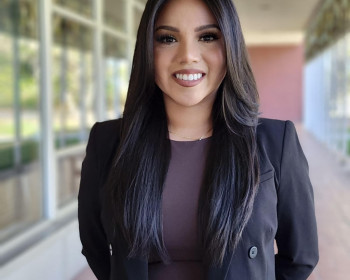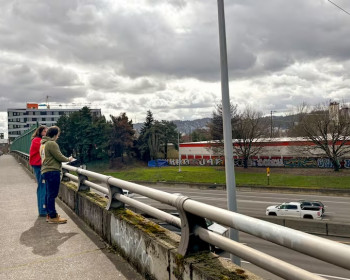Hala Samaan
(she/her)
Hala Samaan chose to pursue art therapy at Lewis & Clark Lewis & Clark for three distinct reasons: its commitment to social justice and equity; the optional Licensed Professional Counselor (LPC) track; and beautiful Portland, Oregon.

After extensively researching the field of art therapy, Samaan chose Lewis & Clark Graduate School of Education and Counseling for three distinct reasons—its genuine commitment for social justice and equity WITHIN the program; because Lewis & Clark offers an optional Licensed Professional Counselor (LPC) track alongside Art Therapy; and because of its location in beautiful Portland, Oregon.
“The art scene here is big, and it felt like an appropriate place to form connections and potentially start my Art Therapy career here,” she explains.
In Samaan’s first semester in the Art Therapy program, she took a course titled Diversity and Social Equity, where she was able to self-reflect on the biases she was bringing with her and cultivate a learner’s mind.
“It was a rigorous course that gave me space to continuously self assess, reflect, and keep my biases and assumptions in check while maintaining a learner’s perspective and view. The professors in this program really do put effort in challenging the social hierarchy by balancing the power differential in the classroom space,” she says.
Samaan has also found the small cohort experience to be invaluable, especially after moving to Oregon from a different state. She describes her cohort as her “second family away from home,” sharing that this contributes to a warm, open, and supportive relationship between students and faculty as well. She reports that professors often go out of their way to support students, citing a time when a faculty member stayed long after class to help her integrate theoretical frameworks in a particularly challenging assignment.
Having this foundational support helped Samaan to have a positive and meaningful externship experience at Pacific Academy, where she worked with high school students. She describes a 1:1 art therapy session she had with a client who clearly expressed that they were not interested in participating in art therapy with her, giving her the opportunity to utilize her theoretical approach of choice—person-centered therapy.
“In person-centered therapy, the client receives unconditional positive regard from the therapist,” Samaan explains. “With this approach, I was able to listen to my client’s needs and concerns and later discovered that what they really needed at that moment was to play with 3D art materials. I then provided a plethora of textured materials, and with excitement they told me “my artistic brain is exploding!” and they started working on their art piece for the duration of the time that we had together. This experience helped strengthen the student’s trust with me, and has also helped solidify my Art Therapy journey even more.”
For prospective students who are considering the graduate school’s art therapy program, Samaan recommends having a strong self-care practice prior to applying and carrying it with you throughout the graduate school process, as well as being willing to ask questions for clarification whenever they come up.
She adds that choosing the Art Therapy program at Lewis and Clark “has been a life changing experience for me…it is a rigorous program, but the rewards are life changing if you choose to put in the work.”

